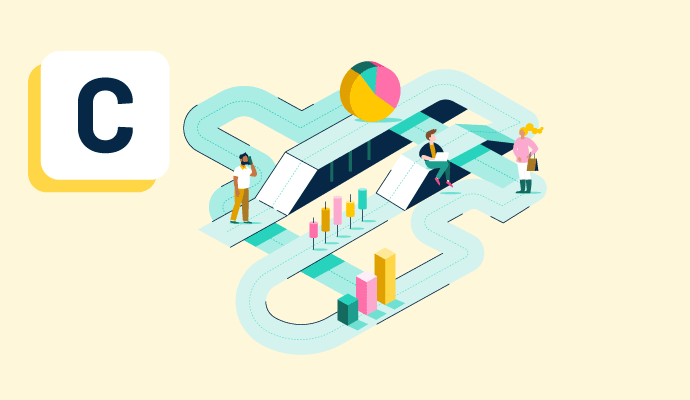What is a customer data platform?
A customer data platform (CDP) is software that gathers and integrates customer data across various touchpoints in one centralized software.
Information in CDPs is then used to build customer profiles based on real-time, individual data. Marketing and sales teams use these platforms to retain existing customers or attract new ones.
Specialist customer data platform software enables companies to track customer interactions with the brand online and offline. Understanding what each customer wants, businesses can personalize their next interaction to encourage engagement and, potentially, a purchase through an enhanced client experience.
Types of customer data platforms
Not every business uses the same software or has the same data points regarding customer information. The integrations that need to be made between a CDP and existing tools determine the type of CDP a business uses. In terms of their capabilities, the most common types of CDP are:
- Data CDPs. The most basic type, data CDPs consolidate and unify customer information gathered from multiple different sources. Data CDPs sort and store this data in one location.
- Analytics CDPs. A step up from data CDPs are analytics CDPs. They use artificial intelligence (AI) to analyze customer profiles within the CDP and make predictions about customers.
- Campaign CDPs. Marketing campaigns often make use of CDP data and customer profiles. These CDPs can generate highly-segmented audiences to increase the probability of conversions and sales for various marketing campaigns.
- Delivery CDPs. The most common type of delivery CDP is an email marketing platform. Teams use delivery CDPs to collect customer information and send out additional marketing content via email. Delivery CDPs are typically self-contained tools, integrating with other platforms to gather data initially before running analytics.
Basic elements of a customer data platform
No matter which, every good CDP should have the ability to collect and analyze customer data that comes in via various other tools or software. The centralized hub should have several basic elements, including:
- Raw data. Customer information coming into the CDP is formatted in various ways depending on where it comes from. The CDP should be able to store this raw data in its original format.
- Analytics and reporting. Even the most basic CDPs should have some reporting functionality. This makes it possible for teams to assess customer behavior and engagement with the business before segmenting them into audiences.
- Single customer view (SCV). CDPs should be able to apply their data to create a single record about a group of customers. Marketers can then use this info to identify customer desires and target their messaging accordingly.
Benefits of a customer data platform
With so much customer information coming into a business at any given moment, keeping track of it all in a meaningful and usable way is difficult without a centralized system. CDPs are beneficial because they:
- Keep customer data more organized. The learning curve is usually steep for teams first using a CDP, but once other software is integrated, it soon becomes much easier to find data quickly and start using it in future marketing and sales campaigns.
- Give greater insight into customer behavior. Through the collection, sorting, and analysis conducted within a CDP, how customers engage with a brand becomes more apparent. What’s working well for one audience segment may fail with another. But knowing this data means that teams can proactively make better decisions around marketing, product development, and customer service.
- Protect customer information. With the General Data Protection Regulation (GDPR) rolling out across Europe and other parts of the world with similar measures, finding ways to protect user privacy and customer data is essential. Many CDPs come with built-in security measures that encrypt private data and delete it when it’s time.
Best practices for using a customer data platform
When integrating a CDP into a business, the list of possible ways to use the data gathered is long. Some options are specific to the type of CDP, but most companies should always try to:
- Determine why the CDP is being used. Understanding business goals and how the CDP supports them gives teams greater agency to focus on the most important pieces of data while filtering out information that isn’t as meaningful for reaching business key performance indicators (KPIs).
- Adequately train employees across different departments. With information coming into the CDP from different sources, more than one team already gathers information with their current tools, while also having access to new data. Cross-department training on how to use the CDP should be completed frequently.
- Set a data retention policy. No business needs to hold onto customer data forever. In many cases, like with GDPR, it’s not even legal any longer. Companies using CDPs must create firm guidelines for how long information is kept and how it will be securely destroyed or returned to the customer once it is no longer needed. This is an important way to stay compliant with many data privacy laws.
- Frequently review raw data for duplicates. Any information being pulled into the CDP significantly affects the customer profiles. If data is duplicated in any way, this can skew results and create ineffective profiles. Having systems in place to review and clean incoming data feeds is an important step to keep information as accurate as possible.
Integrate customer data platforms into your business and benefit from predictive analytics software that can determine patterns and trends to boost your customer engagement and sales.

Holly Landis
Holly Landis is a freelance writer for G2. She also specializes in being a digital marketing consultant, focusing in on-page SEO, copy, and content writing. She works with SMEs and creative businesses that want to be more intentional with their digital strategies and grow organically on channels they own. As a Brit now living in the USA, you'll usually find her drinking copious amounts of tea in her cherished Anne Boleyn mug while watching endless reruns of Parks and Rec.




















